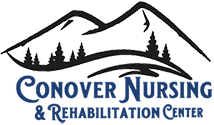Specific Health Conditions
Hip and Knee Replacements
Most people who choose to have a major joint replacement surgery do so because they want the freedom to move and continue their life plans free of pain. Our advanced, proven rehabilitation program can help you reach this goal. Every program begins with an extensive evaluation from both physical and occupational therapists. We use physical therapy to build strength, control, endurance and mobility so you can move safely on your own. We use occupational therapy to help you perform the activities of daily living so you can achieve the goal of your joint replacement — returning to a more mobile, functional life without pain.
Stroke or Transient Ischemic Attack (TIA) Rehab
Experiencing a stroke is life altering for the patient as well as the family. Our in-house staff offers a seamless team approach to stroke rehabilitation which makes it more effective for the patient and provides a support team for the family.
Every person’s journey after a stroke is different, as are their abilities pre- and post stroke. A transient ischemic attack (TIA) or “mini-stroke” produces stroke-like symptoms and may require rehab to regain the prior level of functioning. Given this range of experiences, we begin each personalized treatment with an extensive evaluation by physical, occupational and speech therapists. Physical therapy will address the basics of strength and conditioning to help you start moving safely on your own. If necessary, we’ll teach you to use adaptive equipment like a cane or walker. At the same time, occupational therapy will help you perform the activities of daily living such as dressing, bathing, cooking, medication management, toileting and safety in the home environment. Speech therapy will address aphasia, apraxia and any associated complications with swallowing, speaking or cognitive ability. Together with your family this team will provide education about the risk factors and warning signs, as well as support, to help you reach your highest potential.
Illness or Injury
Illnesses or injuries are not part of our planned future, but they happen and they interrupt our lives. That is why at Conover Nursing and Rehab we strive to return you to your prior level or maximum potential quickly so you can resume the plans that were put on hold. Our in-house team has years of experience with illnesses and injuries that result in general deconditioning as well as those that may lead to permanent changes and may require adaptations to how you will function in your everyday life. Because of the wide variety of changes that can occur as a result of illness or injury, our in-house team always starts with an extensive evaluation and develop an individualized plan that will get you started on the road to recovery. Physical therapy will address the basics of strength and conditioning to help you start moving safely on your own. If necessary we’ll teach you to use adaptive equipment like a cane or walker. At the same time occupational therapy will help you perform the activities of daily living, such as dressing, bathing, cooking, medication management, toileting and safety in the home environment. Speech therapy will address any complications with swallowing, speaking or cognitive ability. Together with your family our team will provide support and motivation to help you reach your highest potential.
Cardiac Rehab or Heart Rehab
Conover Nursing and Rehab works with local cardiologists in providing cardiac rehab for those patients requiring short-term inpatient care. Electing for inpatient care at Conover Nursing and Rehab allows the patient to have everything they need in one place. Rehab can speed your recovery time and reduce the chances of your having a reoccurrence. Your expert rehab team will work with direction from your heart doctor to tailor an individualized rehab plan specific to your condition and personal needs. Our cardiac rehab generally consists of:
- Heart health education: helps you examine your lifestyle and your habits to see if you need to consider a lifestyle change.
- Exercise (indoor track, treadmill, SciFit Stepper): exercise sessions may be structured or unstructured and are individually designed based on patient needs.
- Monitoring by health care professionals for any changes in symptoms.
- A gradual increase in intensity tailored for each individual’s unique needs, abilities and/or limitations.
- Strength training if ordered by your physician.
- Frequent vital sign monitoring depending on each patient’s specific heart issue and/or other health-related problems.
